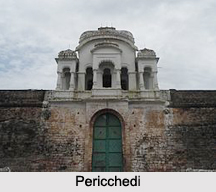 Pericchedi dynasty belonged to a clan of ancient rulers who reigned in Andhra Pradesh and are believed to be the ancestors of the royal family of Pusapati. `Bezawada`, which is the present-day Vijayawada, was created by the Perichhedis during 626 A.D., across Krishna River. Kollipaka was the name of another capital, which was built by the Perichhedis who had resided here for nine centuries.
Pericchedi dynasty belonged to a clan of ancient rulers who reigned in Andhra Pradesh and are believed to be the ancestors of the royal family of Pusapati. `Bezawada`, which is the present-day Vijayawada, was created by the Perichhedis during 626 A.D., across Krishna River. Kollipaka was the name of another capital, which was built by the Perichhedis who had resided here for nine centuries.
History of Pericchedis
The Hindu Dharma was patronised by the Perichhedis which was unlikely to the Chalukyas, who patronised the religion of Jainism.
Pusapati
The name `Pusapati` is a derivation of a Sanskrit term `Pushavat` meaning the sun. This name was utilized in order to emphasize upon the significance of the lineage of the Suryavanshi dynasty. The city known as `Vizianagram` was founded by the Perichhedis and it was named after Vijay Rama Raju. The title of `Gajapathi` was granted to the Perichhedis, following the battle of Nandapur, during the 16th century, near the Northern Circars. Historical records claim that the Maharaja of Vizianagram was a descendant of the Ranas of the kingdom of Udaipur, who constituted the Sisodia branch of the tribe of Guhilot and also Vasishta gotra. During the year 1484, Pusapati Rachi Raju had composed the `Vasistha Gotra Kshatriya Sisa Malika`.
Sultan Kali, who had founded the Qutb Shahi dynasty of the region of Golconda had conquered the Pericchedis, accompanied by several allies of Vijayanagar. However, the fifth king of the lineage of Pusapati was granted the title of `Subehdar` of the Northern Circas by 1652 A.D. The British Government had bestowed numerous honours on Maharaja Rama Gajapati Raju III in the year 1827. The prestigious title of `His Highness` was conferred by Lord Northbrook. Sir P. Vijay Anand Gajapathi Raju was a descendant of the Perichhedis, who had inherited their family estate in the area of Benaras and had wedded the princess of Kashipur.
Rulers of Pericchedis
| Bhimaraja 978 A.D. (Ally of the Chalukyas of Vengi) |
| Pandya |
| Nambaya 1 (Nambiraja) 1043 A.D. (A general of the Vengi Chalukyas) |
| Ganda (Madalika Ganda) 1043 A.D. |
| Nambaya 2 1127-1131 A.D. (Capital in Kalipaka) |
| Pandyaraja 1158 A.D. |
| Teilokya Mallaraju 1159-1161 A.D. |
| Bhimaraja 1161 A.D. |
| Kusumaraja 1161-1230 A.D. |
| Bhimaraja 1230-1268 A.D. |
| Bhimaraja and Uttam Bhimaraja 1268-1283 A.D. |
| Alladanatha Devaraja and Bhimaraja 1283 A.D. |
| Betaraja 1265 A.D. |
| Kesavaraju 1292 A.D. |
| Suraparaja 1292 A.D. |



















